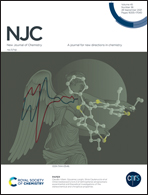Protonation of cyclen-based chelating agents containing fluorescent moieties†
Abstract
The synthesis of three new polyamine receptors based on a common 1,4,8,11-tetraazacyclododecane (cyclen) platform with appended, via a methylene linker, heteroaromatic fluorophores, a single quinoline (Q) or an 8-hydroxy-quinoline (8-OH-Q) moiety (L1 and HL2) or a Q and an 8-OH-Q unit (HL3), is reported. The proton binding features of these receptors, together with those of two similar receptors containing two equal Q moieties (L4) and two Q and two acetate groups (H2L5), have been studied by means of potentiometric, 1H NMR, UV-vis absorption and fluorescence emission measurements in aqueous solution at different pH values. While cyclen is a commonly used binding unit, Q and 8-OH-Q represent classical examples of signalling units in conjugated fluorescent chemosensors and their protonation features can strongly influence their ability in metal cations, and anion coordination and sensing. This study reveals that the structural features of these receptors are controlled by a subtle balance between hydrogen bonding and electrostatic repulsions occurring in their protonated species. At the same time, their emission properties are tuned by photoinduced electron and/or proton transfer processes taking place in the excited state.



 Please wait while we load your content...
Please wait while we load your content...